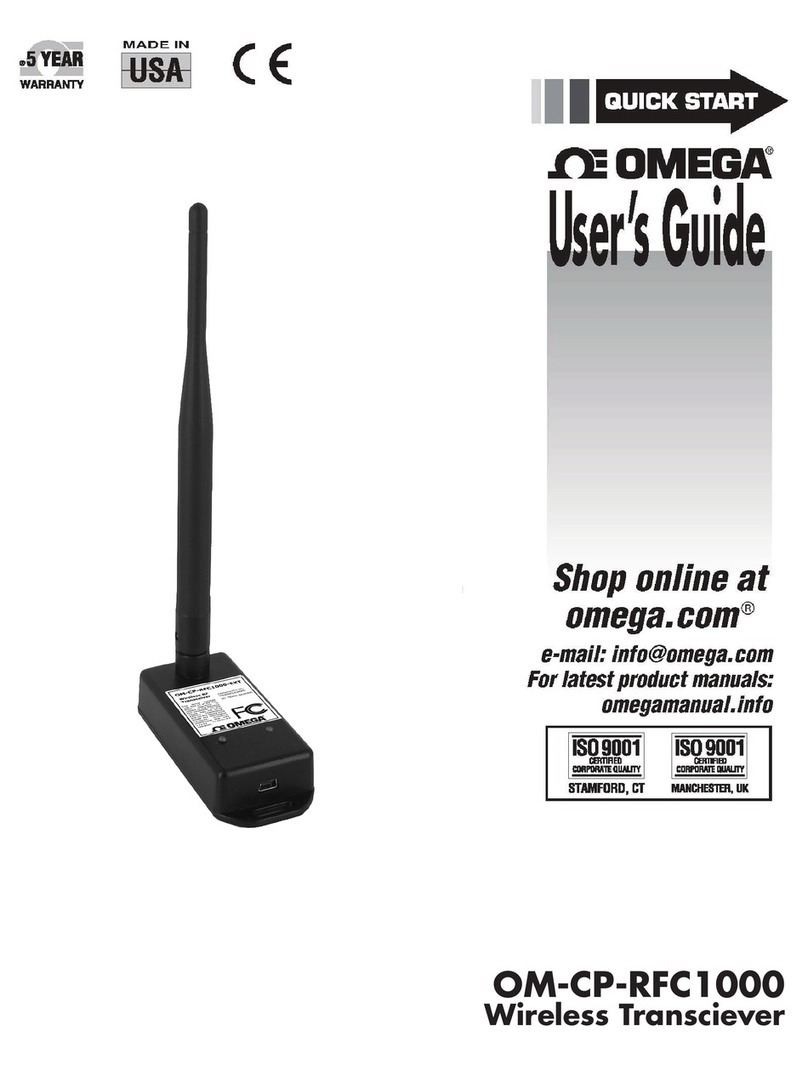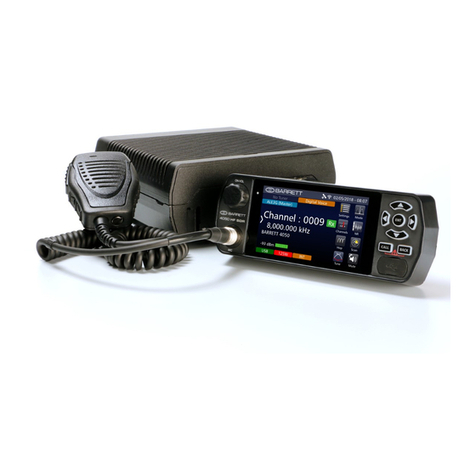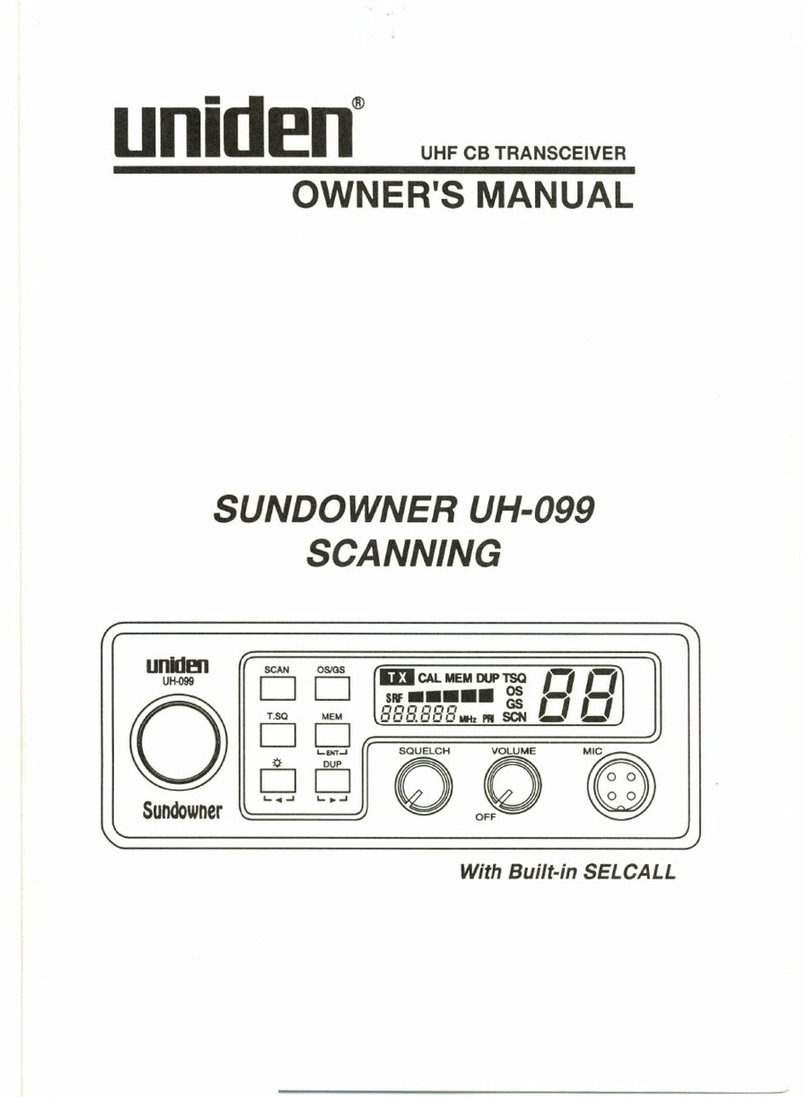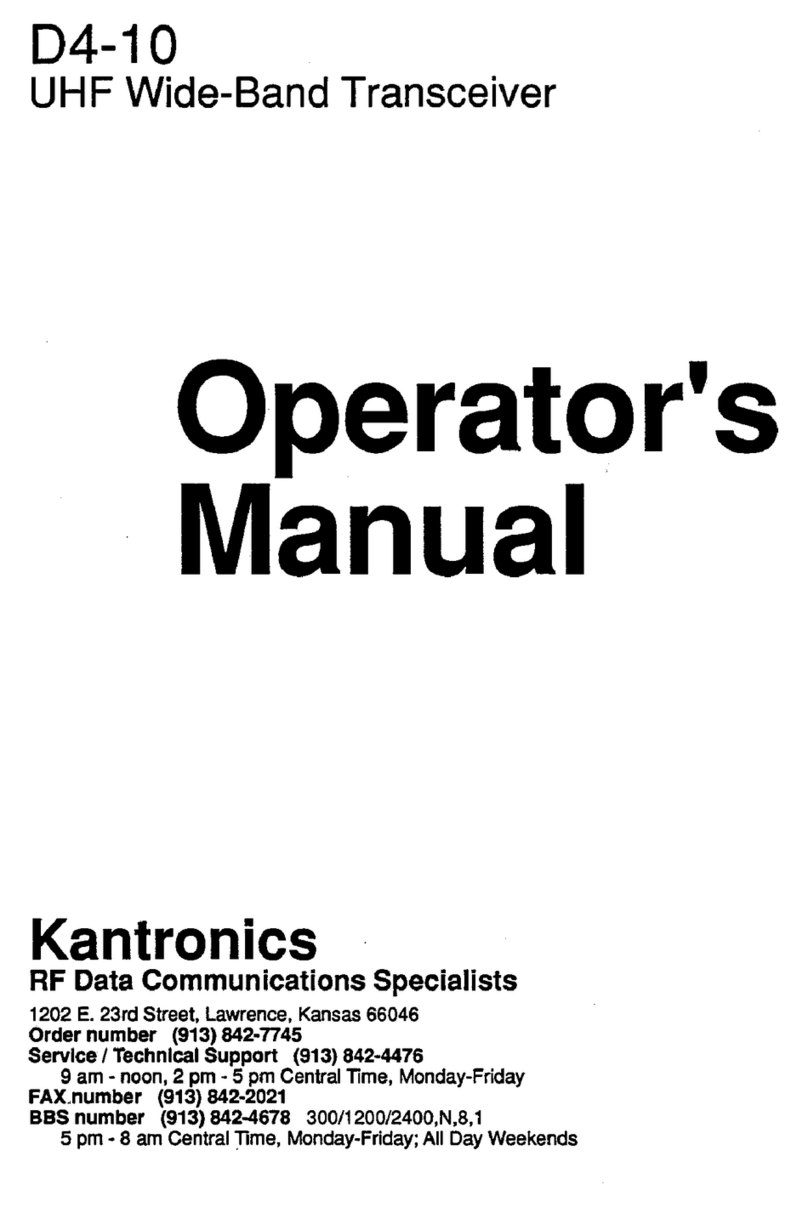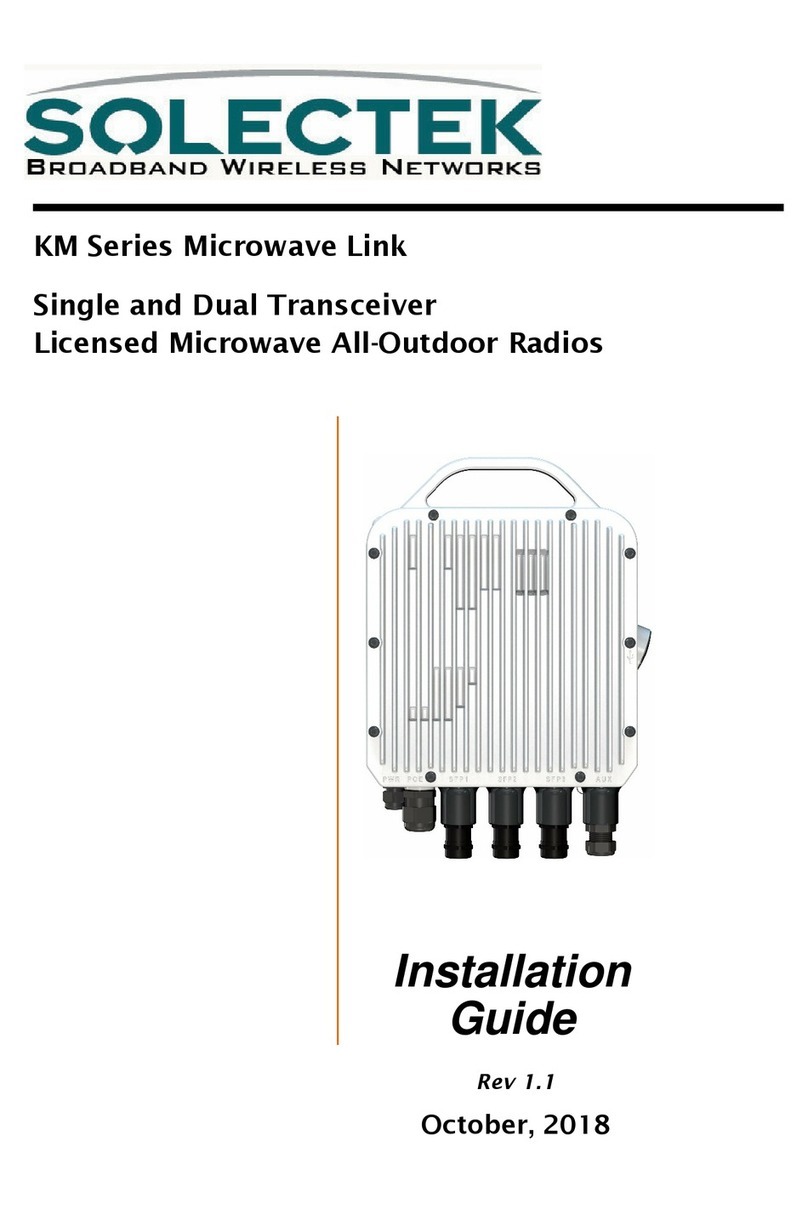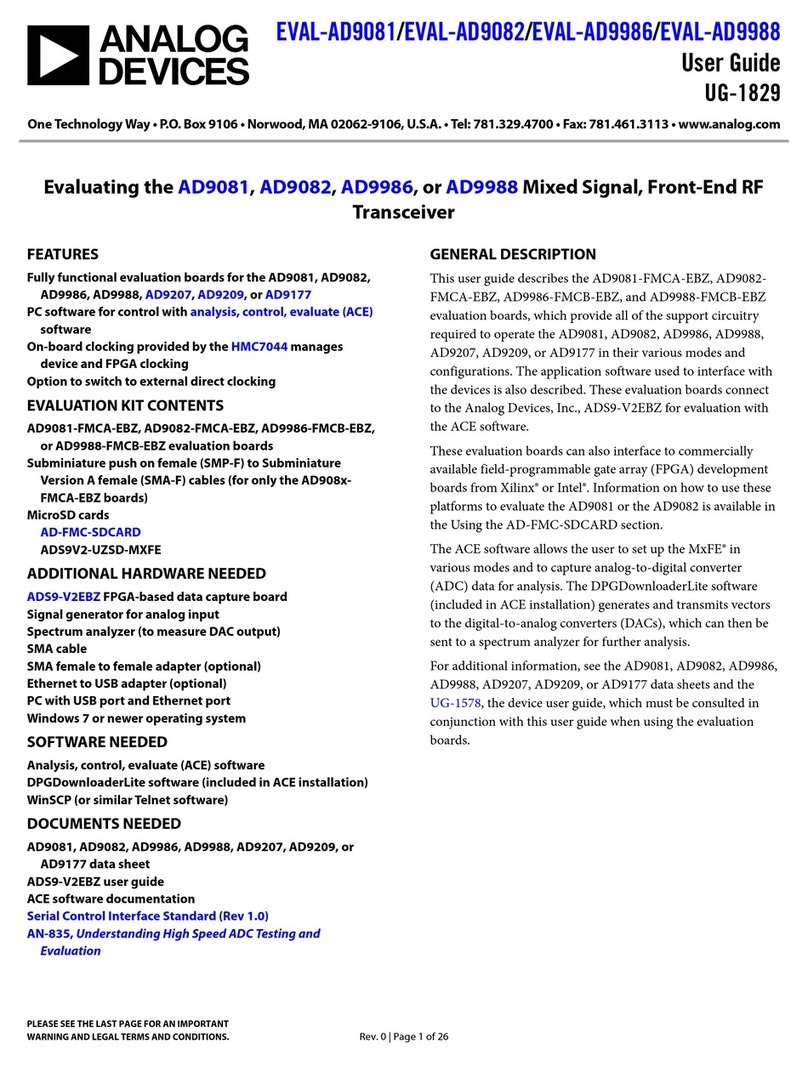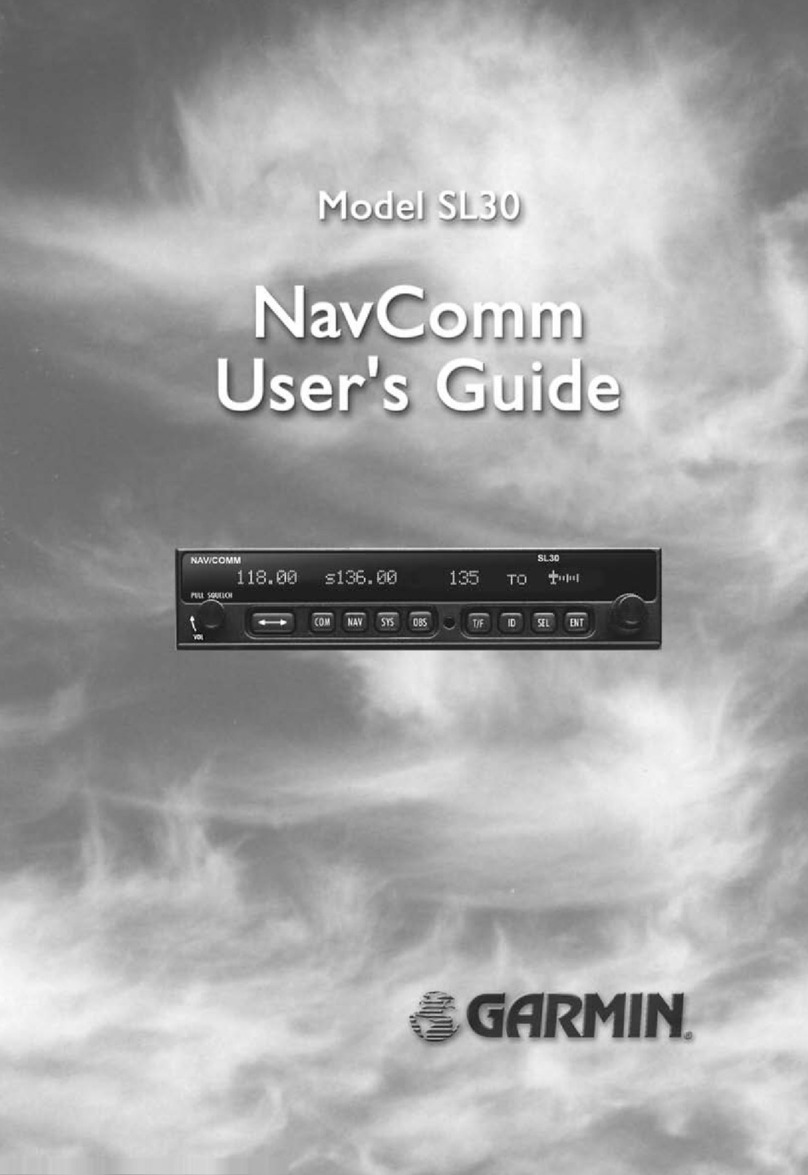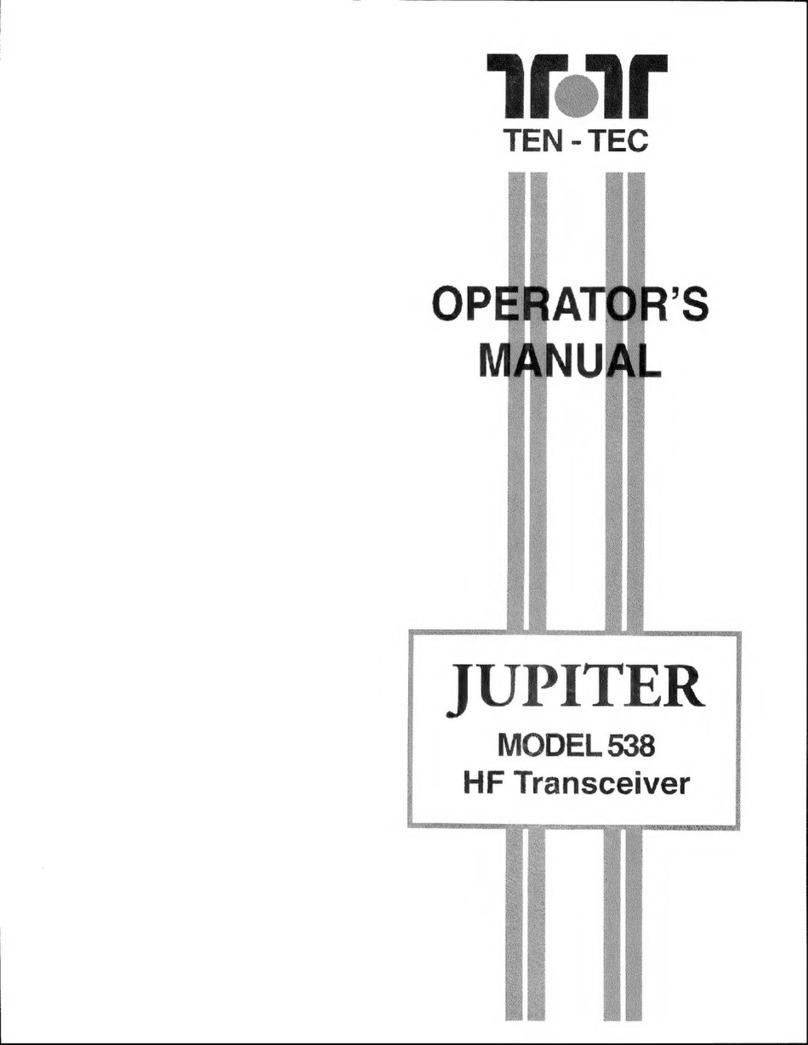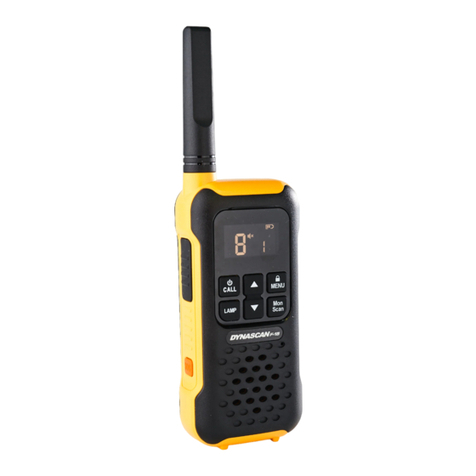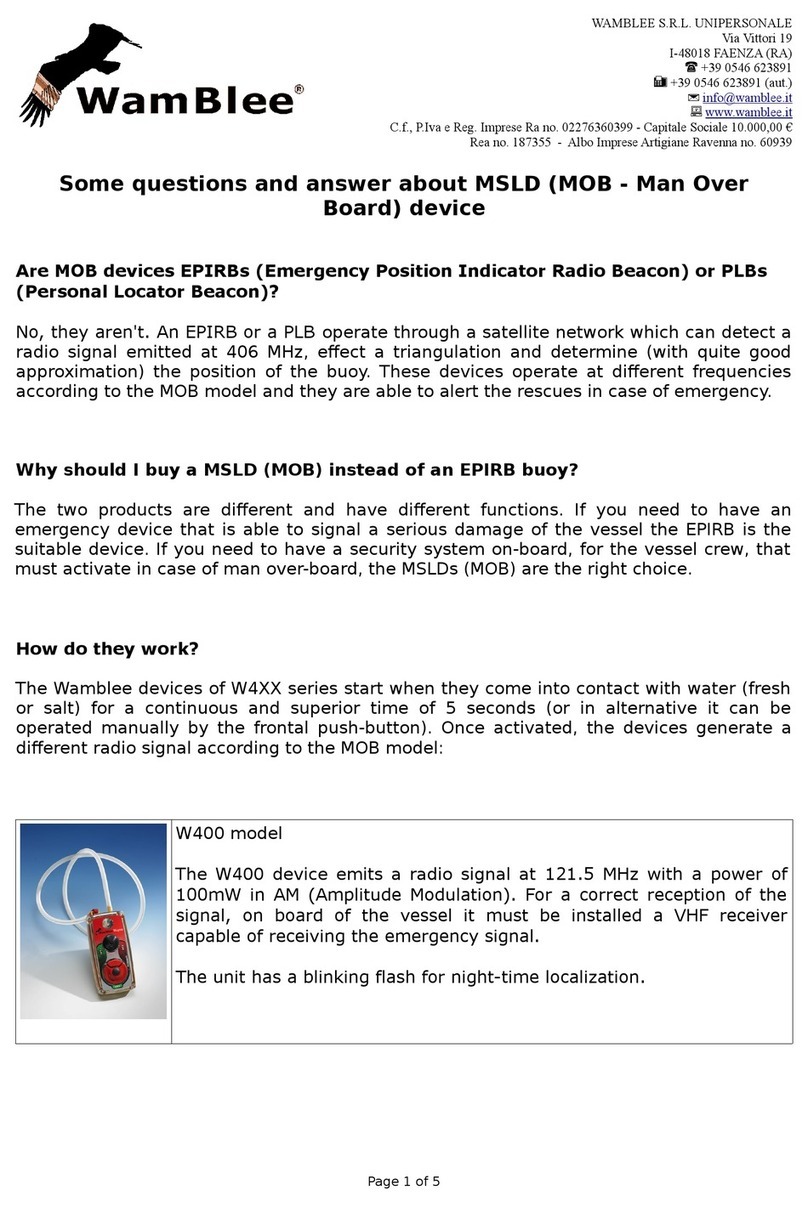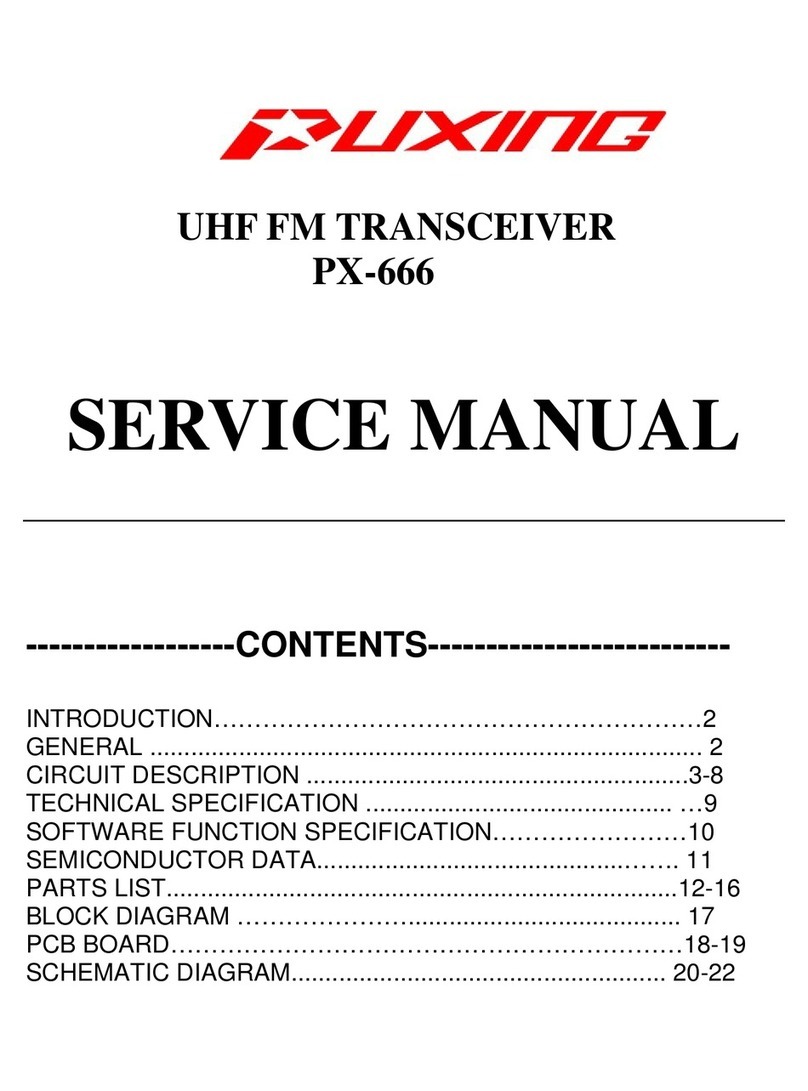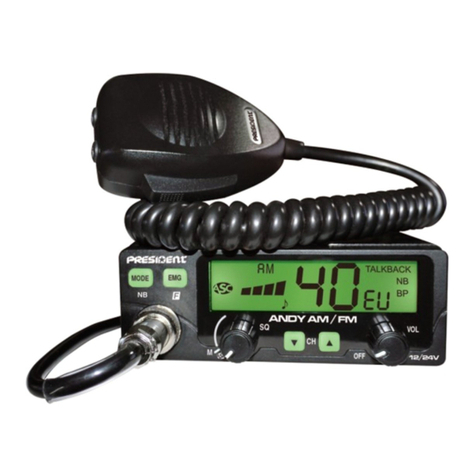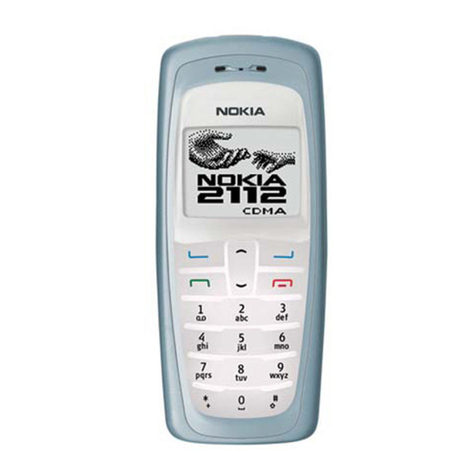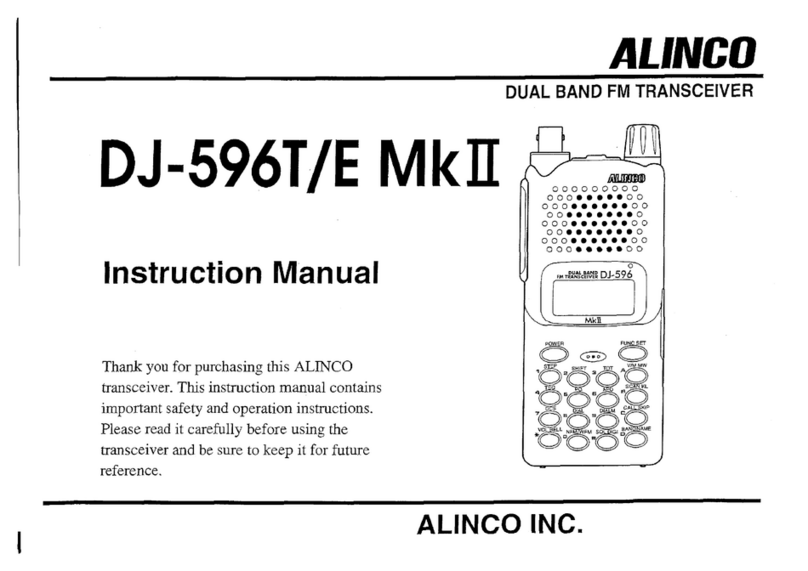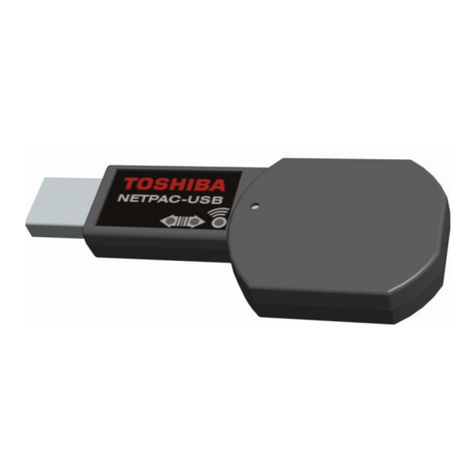Small Wonder Labs PSK-30 Manual

Small Wonder LabsPSK-30 Transceiver Kit 03/09/10 2000 1
PSK-30 Transceiver
Board Kit Instructions
Thanks for purchasing one of the Small Wonder Labs "PSK-30" transceiver kits!
Please take a few moments to look over the sections entitled "First Things First" and "Building Instructions"
before you dive in. These sections contain information which is key to your success with this kit
Note: This version of the printed-circuit board features all through-hole capacitors and only one SMT part
(U8). Please refer to the enclosed sketch for placement of .01 disk capacitors and IC sockets for U3 and U7 and
install those components during assembly. The parts list has been revised to reflect this change.
TABLE OF CONTENTS:
First Things First..................................... 2
Materials ................................................... 3
Parts List ................................................... 4
Theory of Operation ........................... 6
Schematics ................................................. 8
Pictorial Drawing................................... 10
Building instructions , general..........11
Grouped assy. Instr……. 12
"Hooking Up" ................................ 22
Alignment ................................................ 23
Troubleshooting the "PSK-30 " ............... 25
Appendix 1: "Frequently Asked Questions"………26

Small Wonder LabsPSK-30 Transceiver Kit 03/09/10 2000 2
THE FINE PRINT:
There are lots of small parts in this kit. With many of
us getting older, this may prove troublesome. I highly
recommend a magnifying glass or close-up glasses to
check all solder joints and component codes.
THE OTHER FINE PRINT:
If you encounter conflicts between various sections of
this document, contact me for a resolution. The
following order of precedence applies:
•
Schematic (most trustworthy)
•
Parts list
•
Pictorial
•
grouped assembly text
•
Everything else
"This manual vs. QST":
This manual and even the schematic may
change as I find a better way to do things. The
parts we've supplied reflect this manual rather
than the QST article. Put aside the QST and follow
what you find in these pages. Understood?
Documentation updates may be found at:
http://smallwonderlabs.com/psk_docs.htm
TOOLS:
You'll need the following tools:
-Soldering iron- ~25W
- 60/40 solder, small dia.
-Diagonal cutters
-Needle-nose pliers
-Small slot screwdriver
-Wire-strippers (recommended)
-Tweezers (recommended)
TEST EQUIPMENT:
-Multimeter
PSK-30 Power Requirements
.
The PSK-30 is designed to operate with a minimum
supply voltage of approximately 10V. A power supply
capable of delivering a minimum of 1 Amp at 12-14
Volts DC is recommended. Maximum recommended
supply voltage is 15VDC.
A low-cost supply suggestion: Jameco's #169391, 15V
1A regulated 'wall-wart'. They're at 800-842-3131.
FIRST THINGS FIRST -
-Stuff worth knowing!
COLOR CODES:
Resistor color codes are given in the parts list.
Radio Shack's Color-Code Guide, #271-1210, or the
ARRL Handbook will help. If you're not sure, verify
the resistor values with a multimeter before installing.
For what it's worth, roughly 8% of the male
population is red/green color blind. If you're one of
these, you should be verifying all resistors with a
multimeter before installing them.
The PSK-30 board is double-sided and all holes on
the board are plated-through. This means that you do
not need to solder on the top side of the board.
SOLDERING SKILLS
Hopefully this isn't your first experience with a
soldering iron. If it is, though, or this is your first
solid-state project, here are some tips to ensure your
success:
- Soldering Iron:
Use a small iron in the 25-watt class (such as a Radio
Shack #64-2070) and keep the tip clean. Use a
moistened sponge or paper towel to clean the tip
periodically as you work.
Apply only as much heat as is needed to get a good
joint. A small vise to hold the printed-circuit board
may make soldering easier.
Touch the soldering iron tip to the PC board trace and
the component lead simultaneously. Within a second
or two, apply solder and you'll see the solder flow onto
the junction. Withdraw the solder and then the
soldering iron.
Avoid the temptation to load solder onto the joint
until no more will fit! This is an invitation for trouble,
as solder bridges may form across the closer trace
separations. Here's what the correct and incorrect joint
treatments look like:

Small Wonder LabsPSK-30 Transceiver Kit 03/09/10 2000 3
.
PLEASE READ THE SECTION BELOW BEFORE
REMOVING ANY PARTS FROM THE BOARD
Uh-oh! Sooner or later, you may need to remove a
part installed in the wrong location, or perhaps pull a
component for troubleshooting purposes.
Get yourself a roll of desoldering braid (Radio Shack
#64-2090B). Lay the end of the braid down on the
joint to be cleaned and press the soldering iron tip over
the braid. Within several seconds you'll see the braid
begin to wick up solder from the joint. Remove the
braid and reapply a new section as needed until the
joint is clean. It may be necessary to pull the
component out from the top side of the board while
heating the joint. Leave the iron tip on the board only
as long as necessary to do the job- the PC-board traces
will eventually delaminate (peel off) if overheated.
If that still doesn't do the job, it may be necessary to
cut the offending part off on the top side and pull the
remaining leads through with pliers. Contact me for
replacement parts if necessary.
If you need to remove a transistor, I'd highly
recommend sacrificing the part by snipping it off on
the top side of the board. The leads are best pulled out
singly to minimize the risk of lifting pads.
After removing a component from the board, the
through-hole will probably still be blocked with solder.
Use a dissecting needle or dental probe (explorer),
apply heat to the probe and the board trace
simultaneously until the tool pushes through. Lacking
either of these tools, a round wooden toothpick works
well also!
WINDING TOROIDS:
-Count as you go. Draw each turn snug against the
core to ensure a trim and tight winding
-Double-check the turns count when you're finished.
Use your fingernail or small screwdriver to "bump"
over each turn as you count- this is considerably easier
than counting by eye.
- Trim the excess wire off to about 1/4" and strip the
insulation off the ends. See the text for each toroid for
a description of this process.
Counting the turns:
If the wire passes through the toroid center hole, it
counts as a turn. Here's an example:
MATERIALS-
You'll find the following items with your PSK-30 kit:
1- bag of small parts (resistors, caps, wire, etc)
1- antistatic bag (contains semiconductors)
1- envelope labeled "Zeners"
3- envelopes labeled 'L5','L6' and 'L10'
1- printed circuit board
- (this manual)
Please- Organize and inventory the parts collection
before starting- it's much more enjoyable for both of us
if any shortages are identified up front! A chunk of
foam used to pack consumer electronics makes a
handy place to line up parts.
REFERENCE DESIGNATORS:
Each component is uniquely identified with a
reference designator. Bypass capacitors are identified
as C101 and up. Reference designators are shown in
blue on the schematic pages.
GOOD
SOLDER FILLET IS CONCAVE AND 'WETS'
SMOOTHLY TO COMPONENT LEAD
BAD
SOLDER FILLET IS CONVEX OR DOES NOT
ADHERE TO COMPONENT LEAD
This toroid is wound with 8 turns
Turns must be uniformly distributed around
the circumference of the toroid.

Small Wonder LabsPSK-30 Transceiver Kit 03/09/10 2000 4
C
OMPONENT IDENTIFICATION
:
•
Resistors and RF chokes
This manual describes the color coding for all resistors
and RF chokes. Only the first three bands are
described, the fourth band is a tolerance code, typically
gold (=5%) and is not listed. All resistors are 1/4W 5%
carbon film types, RF chokes are also an axial (leads
out of each end) component but are notably larger.
•
Capacitors:
Here's the general rule for capacitor nomenclature:
If 3 digits are printed on the capacitor, the first two are
significant figures and the third is a multiplier.
Examples:
'471' = 47 x 10
1 =
470 pF
'103' = 10 x 10
3 =
10,000 pF = .01 uF
Letter suffixes: J=5%, K=10%, M=20%.
Please: If you're looking for a '104' monolithic cap,
be sure to inspect both sides of the caps before
concluding we gave you the wrong value!
Monolithic caps:
The printing on these parts is tiny! I'd highly
recommend using a magnifying glass to verify
component values before installing them.
If these parts are supplied with a 0.1" (2.5mm) lead-
spacing for installation in a board hole-spacing of 0.2"
(5 mm), bend the wire leads gently to spread the
spacing . Avoid sharp bends right at the wire-lead exit
from the epoxy case; this may cause component
damage/failure.
•
Extra information on components
There's often extraneous information marked on
components. Examining a sample IC, I find
"MC1458P1 KKJK 8949". You care only about the
'1458' or other markings I've specified If I've specified
a capacitor '104' and you find the correct number of
parts, but marked "104M', for instance, those are
them! 'Dr. Suess' called it 'Calculatus Eliminatus' - a
wise man indeed!
IF Transformer (T1):
Although not illustrated on the schematic for reasons
of drawing clarity, T1 contains an internal capacitor
within its base. Do not remove this capacitor.
PARTS LIST
Quantity Reference Designator Value Description Markings or Ident.
1 C35 4.7 pF NPO disk cap '4.7'
10 C8-C12,C25-C29 15 pF 5% NPO disk cap '15' or '15J'
1 C48 4-20 pF 6mm trimmer cap Red
1 C44 6-30 pF 6mm trimmer cap Green
1 C1 33 pF 5% NPO disk cap '33'
2 C7,C17 47 pF 5% NPO disk cap '47' or '47J'
5 C3,C34,C36,C49,C50 100 pF 5% C0G cap, monolithic '101' or '101J'
1 C51 120 pF 5% C0G cap, monolithic '121' or '121J
3 C45,C46,C47 180 pF 5% C0G cap, monolithic '181' or '181J'
3 C38,C40,C43 220 pF 5% C0G cap, monolithic '221' or '221J'
1 C13 330 pF 5% disk cap '331' or '331J'
5 C4,C33,C37,C41,C42 470 pF 5% C0G cap, monolithic '471' or '471J'
27 C2,5,6, C14,16C30-32,
C101-106,C108-C117,
C122-124
.01 uF disk capacitor '103' or '103M'
6 C15,19,39,C118,C119,C121 .1 uF monolithic cap '104'
2 C21,C22 1 uF electrolytic cap
1 C20 3.3 uF electrolytic cap
2 C18,C23 10 uF electrolytic cap
1 C24 47 uF electrolytic cap

Small Wonder LabsPSK-30 Transceiver Kit 03/09/10 2000 5
Parts list (cont'd)
Quantity Reference Designator Value Description Markings or Ident.
2 C107,C120 220 uF electrolytic cap
13 D1-D7,D10,D13-D17 1N4148 signal diode
2 D8,D9 1N5236 7.5V zener diode In 'Zeners' envelope
2 D11,D12 1N4001 1 Amp rectifier diode (heavy leads)
3 J1-J3 3.5mm stereo jack
1 J4 DB-9 (serial port) connector
1 J5 2.1/5.5 mm power jack
1 J6 BNC jack
1 L1 6.8 uH 5% RF choke Blue-grey-gold-gold
1 L2 1.8 uH 5% RF choke Brn-grey-gold-gold
3 L3,L8,L9 2.2 uH Tunable coil, metal-can "TKANS T9447"
1 L6 8.2 uH SMT inductor In 'L6' envelope
1 L4 22 uH 5% RF choke Red-red-blk-gold
1 L5 33 uH SMT inductor In 'L5' envelope
1 L7 5.6 uH 5% RF choke Grn-blue-gold-gold
1 L10 1.5 uH SMT inductor In 'L10' envelope
2 L11,L13 T37-2 toroidal inductor, 15 turns Red core
1 L12 T37-6 toroidal inductor, 19 turns Yellow core
2 L14,L15 18 uH SMT inductor In 'L14/L15' envelope
1 Q1 J310 JFET plastic pkg.
1 Q2 2N2222A NPN transistor metal pkg.
1 Q3 2N3906 PNP transistor plastic pkg.
2 Q4,Q12 2N7000 MOSFET transistor plastic pkg.
4 Q5-Q8 2N4401 NPN transistor plastic pkg.
1 Q9 MPSH10 NPN transistor plastic pkg.
1 Q10 2N5109 NPN transistor metal pkg
1 Q11 2SC2166 NPN RF power transistor TO-220 pkg., 'C2166'
3 R54-R56 1.5 ohm Resistor, 1/4W, 5% Brn-grn-gold-gold
5 R7,R17,R47,R51,R52 10 ohm " Brn-blk-blk-gold
3 R1,R41,R53 51 ohm " Green-brwn-blk-gold
5 R2,R8,R13,R39,R46 100 ohm " Brn-blk-brwn-gold
2 R4,R10 150 ohm " Brn-grn-brn-gold
3 R20,R44,R48 220 ohm " Red-red-brn-gold
3 R6,R35,R38 470 ohm " Yellow-viol-brn-gold
2 R9,R11 680 ohm " Blue-grey-brn-gold
6 R5,R14,R43,R49,R60,R63 1K ohm " Brn-blk-red-gold
5 R3,R24,R34,R37, R57 2.2K " Red-red-red-gold
1 R42 3.0K Org-blk-red-gold
5 R12,R19,R30,R32,R50 4.7K " Yellow-viol-red-gold
7 R15,R18,R23,R25,R27,R29,
R33,
10K " Brn-blk-org-gold
5 R26,R28,R45,R58,R61 22K " Red-red-org-gold
1 R22 33K " Org-org-org-gold
4 R31,R36,R59,R62 47K " Yellow-viol-org-gold
1 R16 510K " Grn-brn-yel-gold
1 R21 1M " Brn-blk-grn-gold
1 T1 10.7 Mhz IF Transformer, metal can "42IF123"
1 T2 FT50-43 4 turns bif. winding,see text grey toroid
2 U1, U6 TUF-1 or
TFM-2
Mixer 4-pin metal can
1 U2 MC1350 IF Amplifier IC 8-pin DIP pkg

Small Wonder LabsPSK-30 Transceiver Kit 03/09/10 2000 6
Parts list (cont'd)
Quantity Reference Designator Value Description Markings or Ident.
2 U3,U7 SA612AN,
SA602AN
Mixer IC 8-pin DIP pkg
1 U4 LM1458 Dual op-amp IC 8-pin DIP pkg,
'1458, '4558','5558' or
'HA17458'
1 U5 LM393 Dual comparator IC 8-pin DIP pkg,
'XX393'
1 U8 MAR-3SM Microwave IC, Pre-mounted on
board
1 U9 78L08 Voltage regulator IC TO-92 pkg.
9 Y1-Y5,Y7-Y10 4.00 Mhz Crystal, 20 pF calibration HC-49/U pkg.
1 Y6 6.144 Mhz Crystal, 20 pF calibration HC-49/U pkg.
5 8-pin DIP IC socket
1 4-40 x 1/4" machine screw
1 4-40 Nylon nut
1 HS1 TO-220 heat sink
1 2' (0.6m) power wire
1 3' (0.9m) #24 magnet wire
1 2" (5 cm) desoldering braid
1 P1 2.1/ 5.5mm coaxial plug
1 Telephone wire, 6" (15 cm)
1 Tuning wand, plastic white
Theory of Operation:
This transceiver is a single PC-board design measuring
4.6" x 5.27" (7 x 10 cm). It is functionally a crystal-
controlled SSB transceiver with slightly wider-than-
normal IF passband characteristics. It covers the range
of approximately 10.138 to 10.141 Mhz.
Note: Further description of this design is found in the
June 2000 issue of QST magazine.
Receiver Operation:
The receiver RF input (schematic point 'D') is applied
through a series-tuned resonant circuit (C1/L1) and
limiter (D1-D4) to a low-gain preamplier stage
comprising Q1 and associated components. The
output of this preamp is slug-tuned via inductor L3.
Diode-ring Mixer U1 is fed with a 6.1 Mhz Local
Oscillator (LO) signal and converts the incoming 10.1
Mhz received signal to the 4.00 MHz Intermediate
Frequency (IF). Q2 and associated circuitry are a
mixer post-amp and provide both gain and a
termination for the mixer. The post-amp is followed by
a 6-dB resistive attenuator with two-fold purpose: it
provides a stable load to the post-amp and reduces
filter passband ripple.
Y1-Y4 and associated capacitors are the IF filter. This
filter has a 3-dB bandwidth of approximately 2.8 Khz
and loss under 2 dB. Its output is terminated by R12
(4.7K and U2's input resistance. IF amplifier U2
provides about 30 dB of gain and also serves as the
control point for the AGC function (more on this later).
The IF amplifier output is coupled to the product
detector via T1, a tuned IF transformer.
Product detector U3 receives the 4 Mhz IF amplifier
output and multiplies (mixes) it with a 4 Mhz LO
signal (from schematic point 'E'. This results in an
audio output at pin 5 of that IC. C14 provides rolloff
of the audio to reduce high-frequency 'hiss'. Op-amp
U4-B and associated components provide audio
amplification. This stage has a gain of approximately
50 (34 dB) and provides additional lowpass audio
filtering as well. The output of this stage is
considerably larger than your computer's soundcard
expects to see, and the combination of R19 and R20
attenuates this signal down down a 'soundcard-friendly'
level.

Small Wonder LabsPSK-30 Transceiver Kit 03/09/10 2000 7
Because the active soundcard inputs are always active,
even during transmit, the receiver must be 'muted'
during transmit. Without this feature, the receiver
output will be mixed back through the soundcard (in
parallel with the desired DSP-based transmitter drive)
and cause transmitted signal distortion. MOSFET Q12
provides this function by shorting the receiver output
to ground during transmit.
T-R Switching:
T-R switching is controlled by dual comparator U5 and
associated components. 'RTS' or 'DTR' (DigiPan uses
RTS). is provided by the host computer via the serial
port connection, and is a bipolar signal of
approximately +/- 10V in amplitude. It is negative (-
10V) on receive and switches positive on Transmit.
U5-A rests at 0V during receive and switches to V+ on
transmit. This turns on (unmutes) TX audio FET Q4. It
also turns on RX muting FET Q12.
Comparator section U4-B turns the transmitter bias
switching (Vsw) on a few milliseconds later. This time
delay eliminates a transmitter transient caused by the
shifting DC levels when Q4 turns on. 'Catch' diode D7
rapidly turns off the bias supply when switching back
to Receive to eliminate a similar transient.
The receiver's T-R switch function is provided by C1
and L1, which form a series-resonant circuit. Diodes
D1-D4 limit during key-down and thereby restrict the
signal levels presented to the receiver front-end during
transmit. The double-diode configuration raises the
network's intercept point with respect to W7EL's
original configuration to improve IMD immunity.
Transmitter operation:
Audio from the computer soundcard is applied to
the transmitter via J2 or J3. Q4 is switched on during
transmit and allows soundcard audio to reach the
amplifier stage (Q5 and associated components). Note
that when Q4 is off during 'receive', DC bias is
removed from Q5 and it is also non-conducting. The
combination of Q4 and Q5 provide relatively high
attenuation (>60 dB) of the soundcard audio during
receive. This is necessary since the transmitter's DSB
generator is running continuously- an audio signal
applied to that stage's input would be plainly audible
through the receiver. This situation would lead to
soundcard feedback/distortion on receive without the
presence of this muting function.
Q6 is an emitter follower which provide a 51-ohm
source termination for diode-ring mixer U6. U6 is
driven by a signal from the 4 MHz LO, Colpitts
oscillator Q7 and associated components. The output
of mixer U6 is a suppressed-carrier double-sideband
signal. After passing through the transmit IF filter
comprising Y7-Y10 and related components, the signal
has been reduced to a 4 Mhz SSB signal.
U7 is an active mixer and is fed by the 4 Mhz SSB
signal and by a 6.1 Mhz LO signal from Colpitts
oscillator Q8 and associated components. The output
of this mixer consists primarily of both the sum (10.1
MHz) and difference (2.1 Mhz) frequencies applied to
the mixer. Q9 is an emitter follower used to buffer the
high-impedance output of the mixer. U8 is a
Monolithic Microwave IC (MMIC) and provides
approximately 12 dB of gain.
Because the output of mixer U7 has energy on a
number of frequencies, bandpass filtering is required to
clean up its spectrum. L8, L9 and associated capacitors
form this filter, with input and output impedances of
50 ohms.
Q10 and associated components are the
transmitter's driver stage. This stage is feedback-
controlled by R50 for good linearity and operates
class-A (always conducting). The output of this stage
is L-network matched via L10 and C38 to the Power
Amplifier (PA) base. D11 biases the PA base to the
threshold of conduction, necessary for linear operation.
The PA stage (Q11) features a bifilar transformer (T2)
at its collector. This provides a 1:4 impedance match,
transforming the PA collector impedance at rated
power to 50 ohms. L11-L13 and C40-C43 are a 7-pole
lowpass filter used to remove harmonic content from
the PA output waveform. The design complies with
current FCC requirements for spurious emissions. All
harmonics were down at least 50 dB. The largest
spurious output is down 41 dB.
Output Indicator:
Diodes D13,D14 and associated components are a
peak detector circuit and may be used to as an RF
output indication. If you like, a 'T1-3/4' LED may be
installed at TP2 on the board- this serves as a
modulation indicator. This diode may alternatively be
mounted remotely to the circuit board, since it's
decoupled for RF frequencies by C122.

Small Wonder LabsPSK-30 Transceiver Kit 03/09/10 2000 8
C
10.1 Mhz PSK31 Transceiver
D. Benson, NN1G 6/23/2001
A
E
B
A
D
J2
J3
C113
C22
R33
R37 R38
R34
R35
R3
R39 C24
R40
U
Q4
Q5
Q
R41
C25
C2 C27 C28
C29
Y7 Y8 Y9 Y10
U7
C115 C31
C114
R43 D9
C30
R45
R4
C32
C11
R44
U8
R47
R48
C117
U9
R59
C112
Y5
Q7
R 0
C45
C4
R58C44
L
C47
C48
Y
R 1
C49
C50 R 3
Q8
R 2 C123
L7
C51
C34
C33
C35
TP1
C3
C37
R50
R49
L8 L9
L10
C118
R51
Q10
C38
R52
R53
R54-5
D11
C119
Q11
T2
D12
C121
C120
D10
C39
C40 C41 C42 C43
L11 L12 L13 R57
D13
D14
C122
TP2
J5
Vr
Vr
Vr
Vr
Vr
V+
Vr
Vsw Vsw Vsw
J
.01
ANT.
2.2K
220 uF
.1
.1
1.5 (3 pl)
.1
51
10
.1
10
4.7K
1K
2.2 uH
470
100
4.7
-30 22K
47K
180 (2 pl)
1K
8.2 uH
180
.01
78L08
IN
.144
.01
1 uF
10K
2.2K 470
2.2K
47K
470
10 uF
C23
100 47 uF
2
3
1
(XMTR
AF In)
451
3K
R42 Y7-Y10:
4.000
Mhz
C25-C29:
15
pF
.01
1
2
3
8
5
.01
7.5V
1K
.01
100
22K
220
.01
220
10 .01
.01
.01
5. uH
120
1K
.01
47K
MHz
4.00
MHz
4-20 22K
100
(2 pl)
Q9
MAR-3SM
V+
(not used)
LINE OUT
Vsw
(8V)
L15
18 uH
L14
18 uH
470
100
220 220
470 470
2.2 uH
1.5
uH 220

Small Wonder LabsPSK-30 Transceiver Kit 03/09/10 2000 9
10.1Mhz PSK31 Transceiver
D. Benson, NN1G 6/21/2001
C
Vsw
U5-A
U5-B
RTS (7)
GND (5)
R25
Vr
R27
R2
R28
R29
R30
R31
V+
V+
D7
C21
C111
.01
5
7
8
4
47K
1 uF
3
21
10K
U3
R14
D8
1
2
3
8
5
7.5V
1K
.01
C14
C15
.01
.1
57
4
8
220
C107
R1
C17 47 pF
510K
10 uF
4.7K
220
10K
.01
C108 R18
R19
R20
Q12
V+
R17
10
10K
R15
10K
22K
.01
22K
10K
C110
J4
C
4.7K R32
Q3
C124
2N390
.01
4.7K
V+
U4-B
J1
AF Out
C1
.01
C18
Vr
D15
C19
.1
C10
D5
D
C20
3.3
3
2
1
R21
1M
V+
R22 R23
33K 10K
C13
330
T1
R24
2.2K
C109
.01
28
1
5
3,7
MC1350
U2
100
R13
V+
U4-A
LM1458
E
V+
C105
.01
4
4.7K
.01
R12
C104
C12
4.00 MHz
Y1 Y2 Y3 Y4
C9 C10 C11
C8 C12:
15 pF
C7 C8
47
33
uH
L5
R10
R9
R11
150
80
80
.01
C
R7
R8
C103
Q2
L4
22 uH
10
100
.01
R4
V+
C102
.01
150
1K
470
.01
R5
C5
R
U1
B
3
4
D
S
470
2.2K
100
R3
C4
C3
100
2.2 uH
L3
R2
1
2
.01
51
R1
C2
L2
L1
6.8 uH
1.8 uH
D
33
D1
D2
D3
D4
C1
Q1
V+
.01
C101
D1
D17
DTR (4)

Small Wonder LabsPSK-30 Transceiver Kit 03/09/10 2000 10
L8 L9
BNC
AF OUT AUX. LINE
OUT
L3
T1
T2
L11
L12
L13
D12
D10
TP1
C33
C34
C122
J5 C43
C41
C40
C42
.01 220
470
470
220
470
100
1.5
.1
C121
R57
D14
2.2K
PWR.
J6
J1 J2
J3
R24
100
.1
C36 C37
C119
C35
4.7
D11
R20
R19
220
4.7K
C18
- +
10 uF
.1
C39
10
R52
51
R53
- +
Q10
C20
3.3 D5
D6
U4
C17
R16
47 pF
510K - +
C107
U3 C106
.01
220 uF
U2
R17
D8 R14
1K
10
2.2K
.01
.01
C105
R13
100
.01
C14
C15
C19
.1
.1
C16
.01
R15
10K
U5
C21
R30
R28
C111
.01
4.7K
10K
R29
22K
MCL
TUF-1
MCL
TUF-1
U1
C103
.01
Q12
R27
R22
33K
10K
R21
R23 10K
1M
- +
- +
C22
1 uF 1 uF
.01
C113
Q4 Q5 Q6
U6
R37 R38
2.2K 470
R39
100
47K
- +
C24
47 uF
R36
- +
C23 10 uF
R33
R34
R35
10K
470
2.2K
R40
TEST
C25
Y7
R41
R42
51
3.0K
15
C26
C27
15 15
C28
15 15
C29
Y8 Y9 Y10
C109
Y1
Y2
Y3
Y4
R12
C104
C9
C10
C11
C12
15
15
4.7K
C13
C108
R18
330
.01
10K
.01
C115
U7
.01
15
47 C7
C8
R11
R10
R9
680 680
150
C114
C124
.01
D9
+ -
D13
C1
33
D1
D4
L2
L1
6.8 uH
1.8 uH
220 uF
C120
U9
Q3
C44
Y5
C48 Y6
6.144
C112
.01
10K
R25
Q7
TP2
J4
L5
33 uH
C3
C5
.01
100
.01
.01
470
C101
C102 C4
R3
Q1
2.2K
.01
51
C2
R1
R2
R4
100
150
.01
C110
R32
R31
D7
4.7K
47K 22K
R26
C47
L6
R58
C45 C46
180
180
22K
180 8.2
1K
47K
R59
R60
D15
U8
R46
C32 .01
100
220
R48
Q9
.01
C30
1K
R43 R44
R45
220
22K
C117
.01
C116
Q2
C6
.01
R6 R8
10
100
470
R7 Q11
R5
1K
22 uH
L4
100 100
C123
R61 R62
47K
.01
L7
L10
5.6
C51
120
Q8
R63 1K
C49 C50
22K
10
R47
C38
220
uH
.1
C118
C31
.01
.01
R54
R55
R56
1N4001
R51 10
4.7K
1K
R50
R49
.01
470
D16 D17
C121A
SA
612
SA
612
LM
1458 MC
1350
LM
393
15
15
6/23/01

Small Wonder LabsPSK-30 Transceiver Kit 03/09/10 2000 11
Building instructions:
All parts installed on the PC board should be fully
seated unless otherwise noted in the assembly text..
Static-sensitive Components:
Components noted in bold in the assembly text are
static-sensitive. The following general precautions
apply:
•
Keep these parts in the antistatic bag until you're
ready to install them and handle them no more
than necessary.
•
Ideally, you've got a grounded-tip iron, but if not-
After the part is installed on the board and before
soldering, touch the iron tip to shack ground (if
available) or to a PC-board ground point.
•
Avoid placing these components on paper.
•
Diode Installation:
Some of the diodes are bent for "upright"
installation on the board. Installation polarity is as
shown below. Be sure to note the orientation of the
silkscreened circle on the board and install the diode
body over this hole. The cathode (banded) end of the
diode is oriented at the top. For diodes which are
installed 'lying down', match the banded end to that
shown on the silkscreen.
Installation- Pictorial
Diode-Schematic
banded end
is cathode
Component
Silkscreen
•
Resistor installation:
Many resistors are likewise installed in 'hairpin'
fashion. As with the diodes, try to match the mounting
orientation shown on the drawing. (If mounted as
shown you've got better troubleshooting access to
circuit points from the top side of the board.)
Orientation of color bands on resistors and other
nonpolar devices is not critical.
•
Installing IC sockets:
The "notch" or dot at one end should be oriented as
shown in the pictorial drawings. Doublecheck
orientation before soldering. A suggestion- solder
down two opposite corners of each socket, and then go
back and press a fingertip on the socket from
underneath while reheating both connections in turn.
You may then solder the remaining pads. This
precaution ensures that the socket is well-seated on the
PC board.
Recommended Assembly sequence:
I've specified the sequence detailed in the pages
which follow, but there's nothing sacred about the
order in which the board is populated. Some parts are
best installed in a particular order, as noted within each
group's instructions.
Directions for winding toroids are found within each
group's assembly instructions.
'The Real Men's Corner:'
This is for the folks who don't read instructions- you
know who you are! Be aware of the following:
- Crystals and the driver transistor (Q10) should be
stood slightly (0.5 to 1mm) above the printed-circuit
board to prevent shorts from case to ground.
Here's one other tip if you prefer to work only to the
schematic and master pictorial:
Stuff only a few parts at a time (3-4 pieces). If you try
to add too many parts at once between soldering
operations, you may lose track and wind up with
missing solder joints! Once you've stuffed the parts on
the board, bend the protruding leads slightly outward
to keep them in place while the board is inverted for
soldering.

Small Wonder LabsPSK-30 Transceiver Kit 03/09/10 2000 12
ASSEMBLY INSTRUCTIONS:
The following components are pre-mounted on the
board:
U3,U7,U8, C2,C5,C6,C30-32,
C101-106,C108-117,C122-124
All components should be mounted on the
silkscreened side of the board. Solder
components into place and trim leads after
installation unless otherwise noted . You
may find it convenient to install 3-4 parts at a
time between soldering operations.
Group 1 Assembly:
Group 1 assembly installs the DC power and serial
port connectors, biasing and T-R switching circuitry.
Install the 9-pin (DB-9) serial port connector
at J4.
Install the DC power jack (black, 3 tabs) at J5.
Note: there will be 'play' in the orientation of
this part due to the slot widths - make sure it
is carefully aligned square to the board edges
before soldering all three tabs.
Install diode D12 (1N4001) immediately
below J5. Match the installation orientation as
shown on the silkscreen.
Install electrolytic capacitor C120 (220 UF).
Note: there is no silkscreened reference
designator for this part. Observe the
polarity marking on the device- the dark bar
down one side of the part denotes the negative
lead. Note that the longer of the two capacitor
leads is (+).
Install diodes D16 and D17 (1N4148s, below
J4). Match the installation orientation as
shown on the silkscreen.
Install an 8-pin IC socket at U5. Match the
'notch' orientation as shown on the silkscreen.
Install resistor R25 (10K, brn/blk/org).
Install resistor R27 (10K, brn/blk/org).
Install resistor R29 (10K, brn/blk/org).
Install resistor R28 (22K, red/red/org).
Install resistor R30 (4.7K, ylw/violet/red).
Install resistor R32 (4.7K, ylw/violet/red).
Install resistor R31 (47K, ylw/violet/org).
Install resistor R26 (22K, red/red/org).
Install electrolytic capacitor C21 (1 uF).
Observe the polarity marking on the device as
shown below.
Install diode D7 (1N4148). Match the
orientation of the banded end of the
component to that of the silkscreen.
Install transistor Q3 (2N3906). Match the
orientation of the flat side of the component
to that of the silkscreen.
Install 3-pin IC U9 (78L08). Match the
orientation of the flat side of the component
to that of the silkscreen.
(L3)
D12
J5 PWR.
U5
C21
R30
R28
C111
4.7K
10K
22K
R2710K
- +
1 uF
+ -
220 uF
C120
U9
Q3
C112
10K
R25
J4
R32
R31
D7
4.7K
47K 22K
R26
D16 D17
(ref. only)
R29

Small Wonder LabsPSK-30 Transceiver Kit 03/09/10 2000 13
Group 2 Assembly:
Group 2 assembly installs the receiver 'back-end'
circuitry.
Install 3.5 mm (1/8") audio jacks at J1-J3.
Install an 8-pin IC socket at U4. Match the
'notch' orientation as shown on the silkscreen.
Install R20 (220Ω, red/red/brown).
Install R19 (4.7K, ylw/violet/red).
Install electrolytic cap C18 (10 uF). Observe
the polarity marking on the device.
Install R16 (510K, green/brn/ylw).
Install R17 (10Ω, brown/blk/blk).
Install R14 (1K, brown/blk /red).
Install D8 (1N5236- from 'Zeners' envelope).
Match the orientation of the banded end of the
component to that of the silkscreen.
Install C17 (47 pF disk cap).
Install electrolytic cap C107 (220 uF).
Observe the polarity marking on the device.
Install C15 and C19 (.1 uF monolithic caps),
'104'
Install R15 (10K, brown/blk /orange).
Install C14 and C16 (.01 uF disk caps, '103').
Install diodes D5 and D6 (1N4148). Observe
the installation polarity as shown on the
silkscreen.
Install electrolytic cap C20 (3.3 uF). Observe
the installation polarity as shown on the
silkscreen.
Install R21 (1 Megohm, brn/blk/green.)
Install R23 (10K, brn/blk/orange).
Install R22 (33K, orange/org/org).
Install R18 ((10K, brn/blk/orange).
Install C13 (330 pF disk cap).
Install D15 (1N4148). Match the orientation
of the banded end of the component to that of
the silkscreen.
Install IF transformer T1. Caution: Ensure
that you install the transformer marked
'42IF123' in this location. The slug in this
transformer is colored green.
Install Q12 (2N7000- from antistatic bag).
Match the orientation of the flat side of the
component to that of the silkscreen. This part
is static-sensitive.
MICR.
T1
J1 J2
R20
R19
220
4.7K
C18
- +
10 uF
- +
C20
3.3 D5
D6
U4
C17
R16
47 pF
510K - +
C107
U3 C106
.01
220 uF
R17
D8 R14
1K
10
C15
C19
.1
C16
.01
R15
10K
Q12
R22
33K
R21
R23 10K
1M
C13
C108
R18
330
10K
D15
LINE
OUT
LINE
OUT
.1
C14
J3
SA
612
.01

Small Wonder LabsPSK-30 Transceiver Kit 03/09/10 2000 14
Group 3 Assembly:
Group 3 assembly installs the 4 Mhz and 6.1 Mhz
local oscillators.
Install surface-mount inductor L6 (8.2 uH,
from envelope). Note: the inductor itself is
inside a black plastic carrier. Pre-tin the
inductor pads on the PC board sparingly
with solder before installing the part. Place
this component on the two pad locations and
restrain carefully in place with tweezers. Tack
one end down with the soldering iron, solder
the other end sparingly, and retouch the end
originally tacked down. Good component
alignment is important to ensure that there
are no short-circuits- check your work
carefully for solder bridges.
Install trimmer capacitor C44 (GREEN). Be
sure to orient the 'flat' side of the capacitor
body as shown on the pictorial .
Install trimmer capacitor C48 (RED). Be sure
to orient the 'flat' side of the capacitor body as
shown on the pictorial.
Install one of the 4.00 Mhz crystals at Y5.
Install this component slightly above the
board (0.5 to 1 mm) to prevent the case from
shorting to board traces. This is best
accomplished by installing and soldering the
crystal in place and then retouching the
connection while pulling gently on the
component to lift it slightly.
Install R59 (47K, yellow/violet/org).
Install R58 (22K, red/red/org).
Install R60 (1K, brown/blk/red).
Install monolithic caps C45-C47 (180 pF).
Note: these components are somewhat
fragile. To spread the lead spacing to match
the 0.2" (5mm) spacing on the pads, grasp the
capacitor body between thumb and forefinger.
Spread the wire leads apart outward, taking
care not to bend the leads right at the
capacitor body. The wire leads may then be
re-bent a few mm away from the capacitor
body to re-form them at the correct parallel
spacing.
Install transistor Q7 (2N4401, from antistatic
bag). Match the orientation of the flat side of
the component to that of the silkscreen.
Install the single 6.144 Mhz crystal at Y6.
Provide height clearance as noted previously
for Y5 for this and all remaining crystal
installations.
Install R61 (22K, red/red/org).
Install R62 (47K, yellow/violet/org).
Install R63 (1K, brown/blk/red).
Install C51 (120 pF monolithic cap).
Install monolithic caps C49 and C50 (100pF).
Install transistor Q8 (2N4401, from antistatic
bag). Match the orientation of the flat side of
the component to that of the silkscreen.
Install L7 (5.6 uH RF Choke, grn/blue/gold).
Avoid bending the 'hairpin' component lead
too sharply where it exits the component
body.
Install surface-mount inductors L14 and L15
(18 uH, from 'L14/L15' envelope). Install
these two parts on the underside of the
board directly across C44 and C48 (green
and red trimmers)
Y9
C44
Y5
C48 Y6
6.144
Q7
C47
L6
R58
C45 C46
180
22K
180 8.2
1K
47K
R59
R60
100 100
C123
R61
R62
47K
L7
5.6
C51
120
Q8
1K
C49 C50
22K
uH
R63
180

Small Wonder LabsPSK-30 Transceiver Kit 03/09/10 2000 15
Group 4 Assembly:
Group 4 assembly installs the receiver IF amp, crystal
filter and mixer post-amp.
Install R24 (2.2K, red/red/red).
Install R13 (100Ω, brown/blk/brown).
Install R4 (150Ω, brown/green/brown).
Install an 8-pin IC socket at U2. Match the
'notch' orientation as shown on the silkscreen.
Install R12 (4.7K, yellow/violet/red).
Install surface-mount inductor L5 (33 uH,
from envelope). See the discussion of the
previous page for installation cautions..
Install C7 (47 pF ceramic disk cap).
Install C8 through C12 (15 pF ceramic disk
caps).
Install four of the 4.00 MHz crystals at Y1-
Y4.
Install R10 (150Ω, brown/green/brown).
Install R9 and R11 (680Ω, blue/gry/brown).
Install L4 (22 uH RF choke, (red/ red/black)
Install R5 (1K, brn/black/red).
.
Install R6 (470Ω, yellow/violet/brown).
Install R7 (10Ω, brn/black/black).
Install R8 (100Ω, brn/black/brown)
Install Q2 (2N2222, small metal-can
transistor). Align the tab on the device rim to
match that of the silkscreen.
T1
R24
U2
2.2K
C105
R13
100
C103
C109
Y1
Y2
Y3
Y4
R12
C104
C9
C10
C11
C12
15
15
15
15
4.7K
15
47 C7
C8
R11
R10
R9
680 680
150
(J4)
L5
33 uH
C102
R4
150
C110
Q2
C6
R6 R8
10
100
470
R7
R5
1K
22 uH
L4

Small Wonder LabsPSK-30 Transceiver Kit 03/09/10 2000 16
Group 5 Assembly:
Group 5 assembly installs the first mixer and preamp.
Install R2 (100Ω, brown/blk/brown).
Install R1 (51Ω, green/brown/black).
Install R3 (2.2K, red/red/red).
Install C4 (470 pF monolithic cap, '471J')
Install C3 (100 pF monolithic cap, '101J')
Install L3, Toko shielded Inductor, 'TKANS
T9447'
Install D1 through D4 (1N4148s). Match the
installation polarities as shown on the
silkscreen and on as shown on the figure on
this page.
Install L1 (6.8 uH RF choke,
blue/grey/gold).
Install L2 (1.8 uH RF choke,
brown/grey/gold).
Install C1 (33 pF disk cap).
Install transistor Q1 (J309/J310, from
antistatic bag). Match the orientation of the
flat side of the component to that of the
silkscreen.
Install Mixer U1 (MCL TUF-1 or TFM-2) ,
from antistatic bag). Be sure that the part
labeling is oriented as shown on the figure
on this page and that the part correctly
overlaps the silkscreened outline on the
board.
Caution: This component should be spaced
slightly above the board. Solder only 1 of
the 4 pins into place initially. Adjust
component spacing above the board while
briefly reheating this connection, then solder
the remaining connections.
L3
(J5)
PWR.
MCL
TUF-1
U1
C1
33
D1
D4
L2
L1
6.8 uH
1.8 uH
C3
C5
100
.01
470
C4
R3
Q1
2
.
2K
51
C2
R1
R2
100
C101

Small Wonder LabsPSK-30 Transceiver Kit 03/09/10 2000 17
Group 6 Assembly:
Group 6 assembly installs the audio switch and
transmit first mixer.
Install C22 (1 uF electrolytic cap). Observe
the installation polarity as shown on the
silkscreen.
Install R33 (10K, brown/blk/orange).
Install R34 (2.2K, red/red/red).
Install R35 and R38 (470Ω, yel/violet/brn).
Install R37 (2.2K, red/red/red).
Install R38 (470Ω, yel/violet/brn).
Install R36 (47K, yel/violet /orange).
Install R39 (100Ω, brown/blk/brown).
Install R41 (51Ω, green/brn/black).
Install C23 (10 uF electrolytic cap). Observe
the installation polarity as shown on the
silkscreen.
Component outlines "R40" and "TEST" are unused-do
not populate these locations.
Install Q4 (2N7000- from antistatic bag).
Match the orientation of the flat side of the
component to that of the silkscreen. This part
is static-sensitive.
Install Q5 and Q6 (2N4401- from antistatic
bag). Match the orientation of the flat side of
the components to that of the silkscreen
Install Mixer U6 (MCL TUF-1 or TFM-2),
from antistatic bag). Be sure that the part
labeling is oriented as shown on the figure
on this page and that the part correctly
overlaps the silkscreened outline on the
board.
Note: observe the component spacing
precaution as with U1 on the previous page.
Install C24 (47 uF electrolytic cap). Observe
the installation polarity as shown on the
silkscreen.
MCL
TUF-1
- +
C22
1 uF
C113
Q4 Q5 Q6
U6
R37 R38
2.2K 470
R39
100
47K
- +
C24
47 uF
R36
- +
C23 10 uF
R33
R34
R35
10K
470
2.2K R40
TEST
R41
51
2N7000 2N4401
(2 pl)

Small Wonder LabsPSK-30 Transceiver Kit 03/09/10 2000 18
Group 7 Assembly:
Group 7 assembly installs the transmitter IF filter and
second mixer stages.
Install R42 (3.0K, orange/blk/red).
Install C25 through C29 (15 pF disk caps).
Install the remaining four 4.00 MHz crystals
at Y7-Y10.
Install R43 (1K, brown/blk/red).
Install D9 (1N5236- from 'Zeners' envelope).
Observe the installation polarity as shown on
the silkscreen.
Install R44 (220Ω, red/red/brown).
Install R45 (22K, red/red/orange).
Install R46 (100Ω, brn/black/brown).
Install Q9 (MPSH10, from antistatic bag).
Match the orientation of the flat side of the
component to that of the silkscreen.
C25
Y7
R42
3.0K
15
C26
C27
15 15
C28
15 15
C29
Y8 Y9 Y10
C115
U7
C114
D9
Q9
C30
1K
R43
R44
R45
220
22K
C116
R46
100 (Ref only)
C31
SA
612
Tin each of the crystal cans Y7-Y10 with a
touch of solder at their bases. Using the 2" (5
cm) length of de-soldering braid supplied,
install this braid at the left side of C115 and at
each of the crystal cans as shown below. Use
minimum lead length and trim and discard
any remaining braid length.
[ This assembly step markedly improves
carrier suppression. The crystal filter
impedance are quite high, rendering the filter
susceptible to pickup from the local oscillator
stage without this treatment. ]
C25
Y7
R42
C29
Y8 Y9 Y10
C115
U7
C114
D9
Q9
C30
1K
R43
R44
R45
C116
R46
100
C31
SA
612

Small Wonder LabsPSK-30 Transceiver Kit 03/09/10 2000 19
Group 8 Assembly:
Group 8 assembly installs the transmitter bandpass
filter and driver stages.
Install R47 (10Ω, brn,black,black).
Install R48 (220Ω, red,,red,brown).
Install C33 (470 pF monolithic cap, '471J').
Install C34 (100 pF monolithic cap, '101J').
Install C35 (4.7 pF disk cap).
Install C36 (100 pF monolithic cap, '101J').
Install C37 (470 pF monolithic cap, '471J').
Install L10 (1.5 uH SMT inductor, from the
'L10' envelope
Install L8 and L9 (remaining two Toko
tunable inductors, 'TKANS T9447'.
Install R49 (1K, brown/blk/red).
Install R50 (4.7K, yellow/violet/red). Note:
there is no silkscreened reference
designator for this component. Note its
placement carefully with respect to nearby
silkscreened component outlines before
installing and soldering.
Install R51 and R52 (10Ω, brown/blk/black).
Install C118 and C119 (.1 uF monolithic cap,
'104')
Install D10 (1N4148). Match the orientation
of the banded end of the diode with that of the
silkscreen.
Install D11 (1N4001, power diode). Observe
the installation polarity as shown on the
silkscreen.
Install Q10 (2N5109, from antistatic bag).
Space this component 0.5 to 1mm above the
board surface to prevent shorts to the
transistor case. Observe the component's tab
orientation as shown on the silkscreen.
Install C38 (220 pF monolithic cap, '221J'.
Install R53 (51Ω, green/brn/black).
L8 L9
D10
TP1
C33
C34
470
100
100
.1
C36 C37
C119
C35
4.7
D11
10
R52
51
R53
Q10
U8
C32
220
R48
C117
L10
10
R47
C38
220
.1
C118
1N4001
R51 10
4.7K
1K
R50
R49
470
1.5 uH

Small Wonder LabsPSK-30 Transceiver Kit 03/09/10 2000 20
Group 9 Assembly:
Group 9 assembly installs the transmitter final
amplifier and lowpass filter.
Cut a 12" (30 cm) length of wire from the roll
of magnet wire supplied with this kit. Save
the remaining length for later use.
Using this length of wire , wind 15 turns on
one of the 3/8" (1 cm) diameter red toroids.
After passing the wire through the center hole
each time, pull it snug against the toroid as
you proceed. Make sure that each turn lays
flat on the core- 'crossed' or scramble-wound
turns must be avoided.
Doublecheck the turns count, adjust the
spacing between turns for a uniform
appearance.
Trim the excess wire length to 3/8" (1cm)
and thoroughly strip the insulation off the
lead-ends using a hobby knife. Install at L11.
Using a second 12" wire length and red
toroid, repeat the above sequence and install
this 15-turn toroid at L13 (nearest to board
corner).
Using the remaining wire length and a 3/8"
(1 cm) diameter yellow toroid, wind 19 turns
and install at L12 (mounts at right angles to
the two toroids already installed).
Remove the individual insulated wires from
the 6" (15cm) length of telephone cable.
Select any 2 of the 4 wires and pass both
through the hole in the toroid.
Wrap this wire-pair snugly around the toroid
for one complete turn. It should look like
this:
Proceed to thread the wire pair through the
hole again and draw it snug . Repeat this
threading operation twice more (a total of 4
wire-pair turns through the hole in all).
Caution:
The wires must not cross over each other
as they are laid down on the core (i.e.,
there are no 'twists' built into the wire. If
(color 1) is on the leading edge in the
direction you're winding, it must continue
on the leading edge for all 4 turns.
'Clockwise' and 'counterclockwise' winding
senses are non-critical- either one is fine.
Here's what the result looks like:
Note the way the color-pairs are arranged as
they proceed around the core.
As you look through the toroid hole (as
shown above, confirm that the 2 (first color)
leads protruding are on the left and the 2
(other color) are on the right.
Cut the protruding leads to a length of 1/2",
strip these with the wirestripping tool and
install at T2. Doublecheck the insulation
colors before soldering this component
down.- Orient it so the outline of the toroid
matches the rectangular outline silkscreened
on the board.
Install C40 and C43 (220 pF monolithic caps ,
'221J').
Install C41 and C42 (470 pF monolithic caps ,
'471J').
Table of contents
Other Small Wonder Labs Transceiver manuals
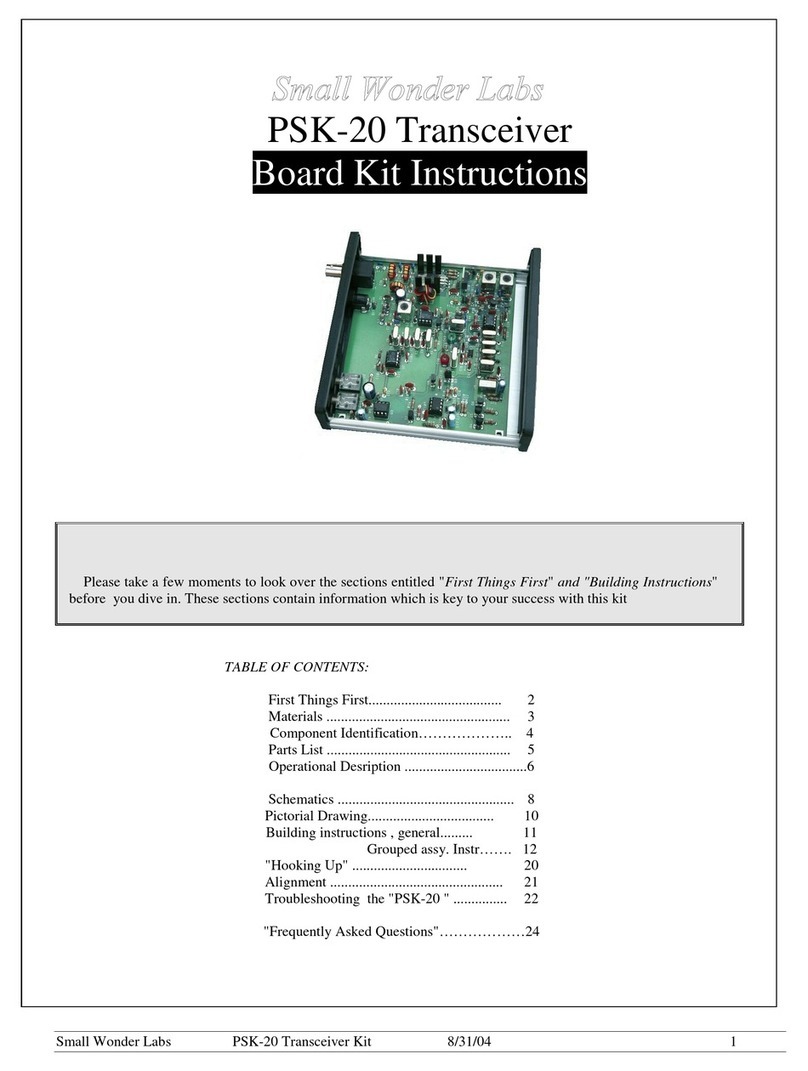
Small Wonder Labs
Small Wonder Labs PSK-20 User manual
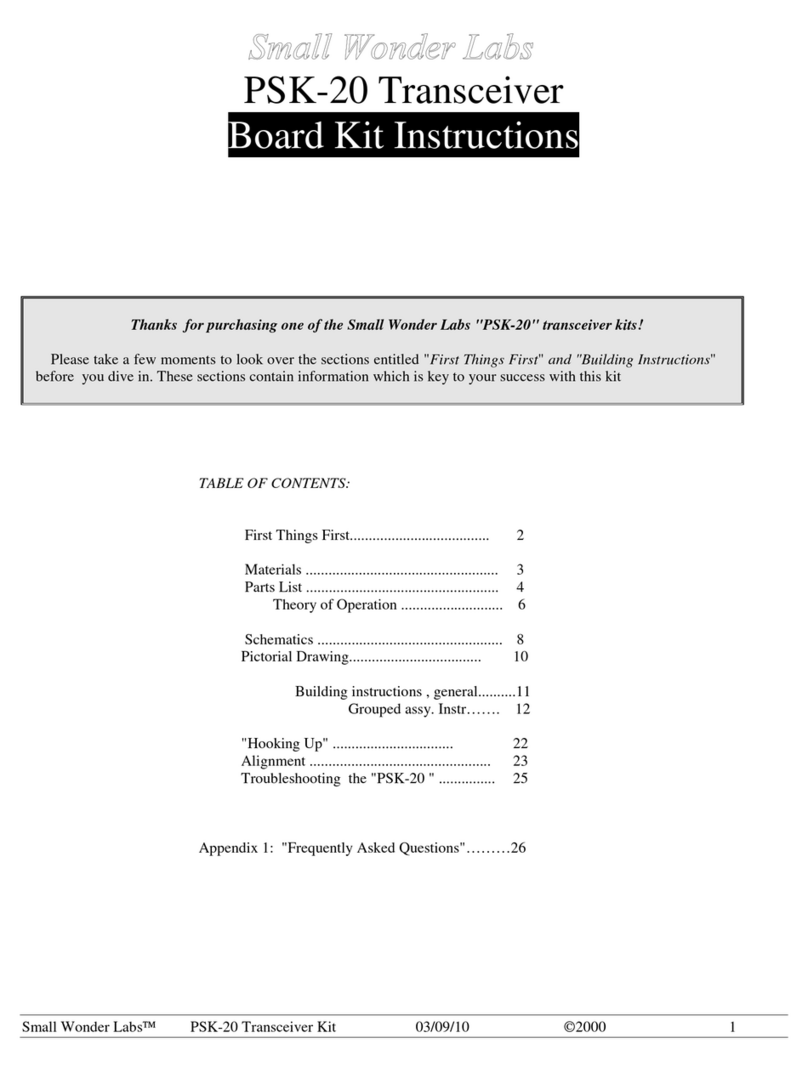
Small Wonder Labs
Small Wonder Labs PSK-20 User manual
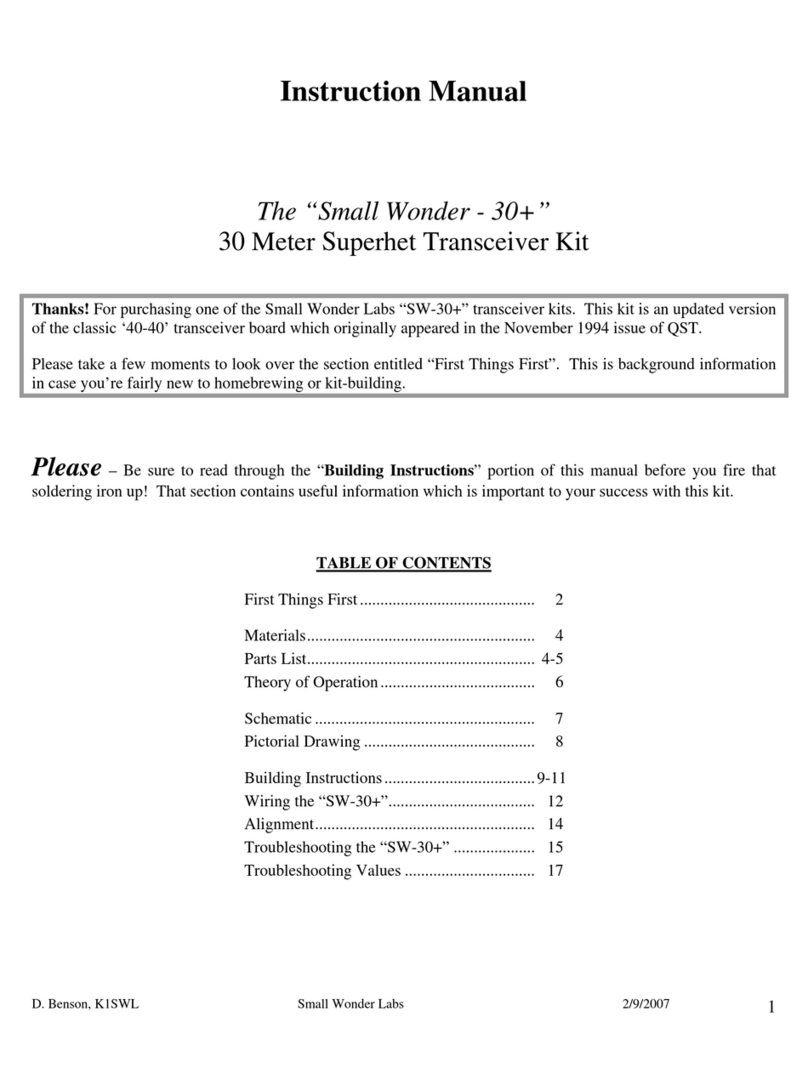
Small Wonder Labs
Small Wonder Labs SW-30+ User manual
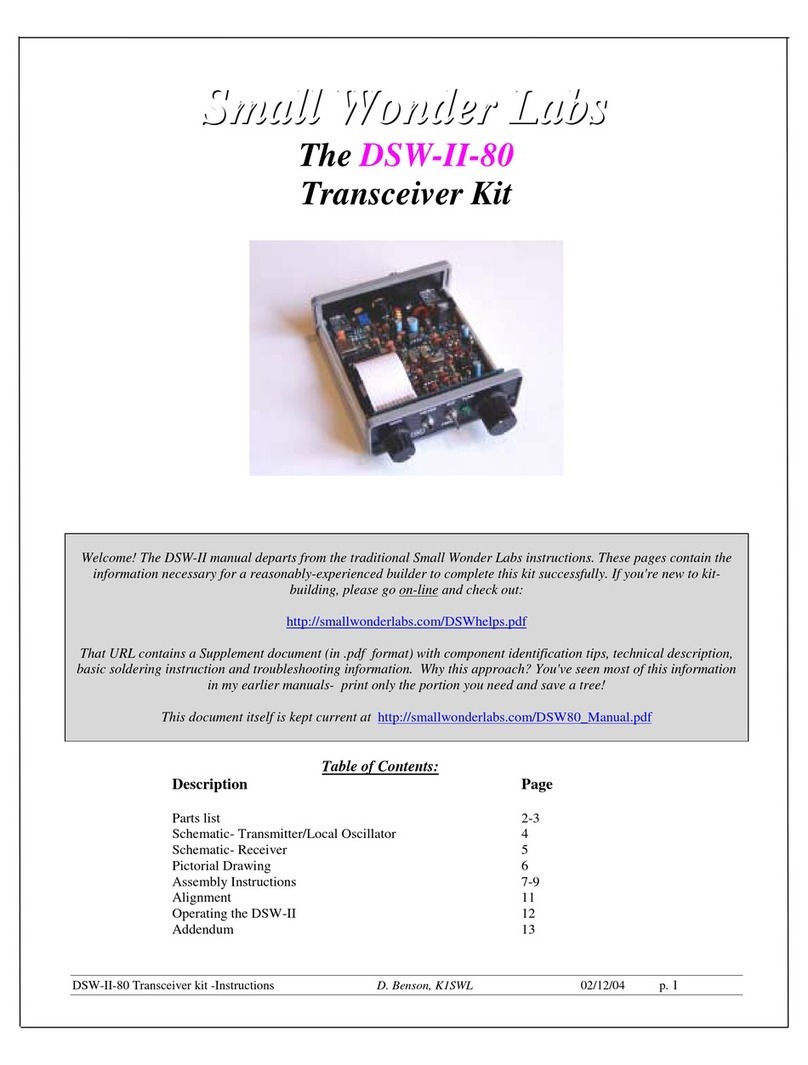
Small Wonder Labs
Small Wonder Labs DSW-II-80 User manual
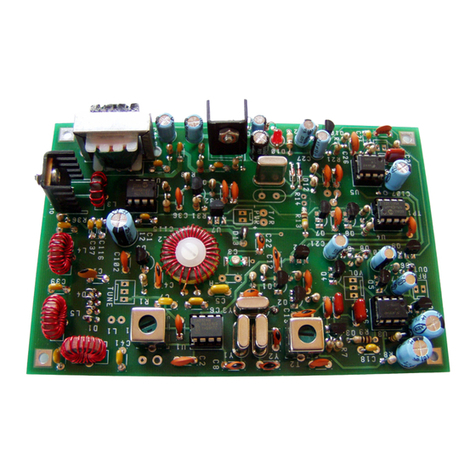
Small Wonder Labs
Small Wonder Labs Retro-40 User manual
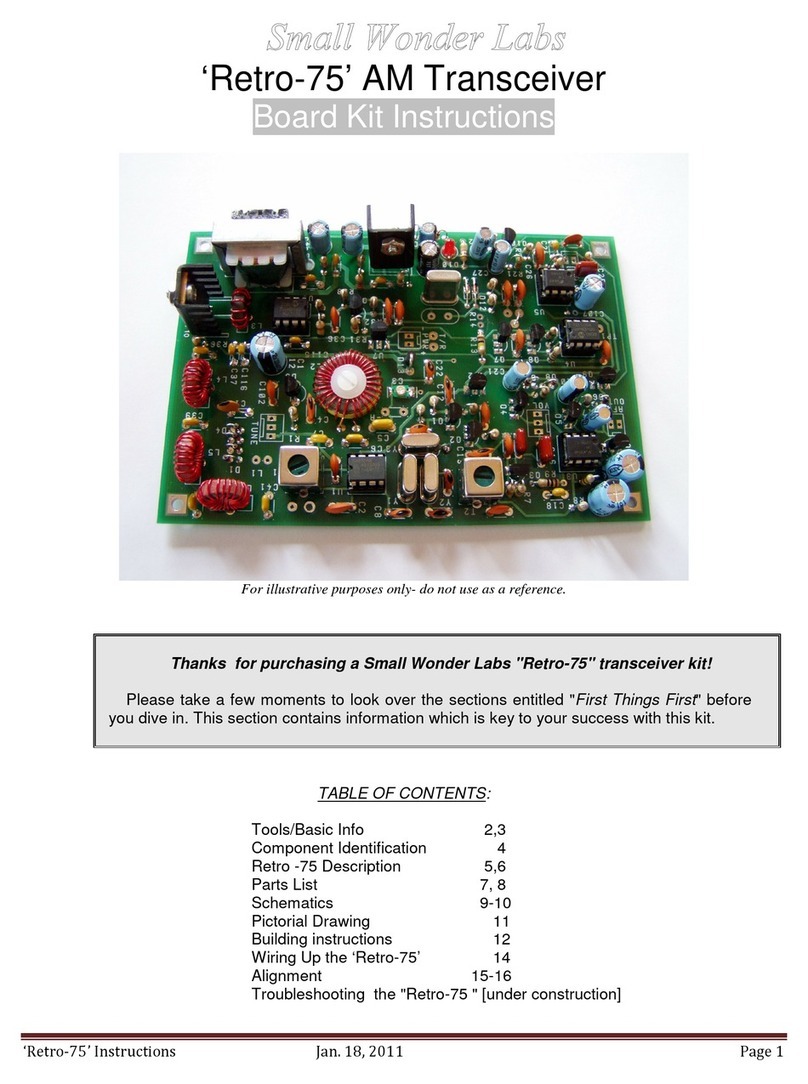
Small Wonder Labs
Small Wonder Labs Retro-75 User manual
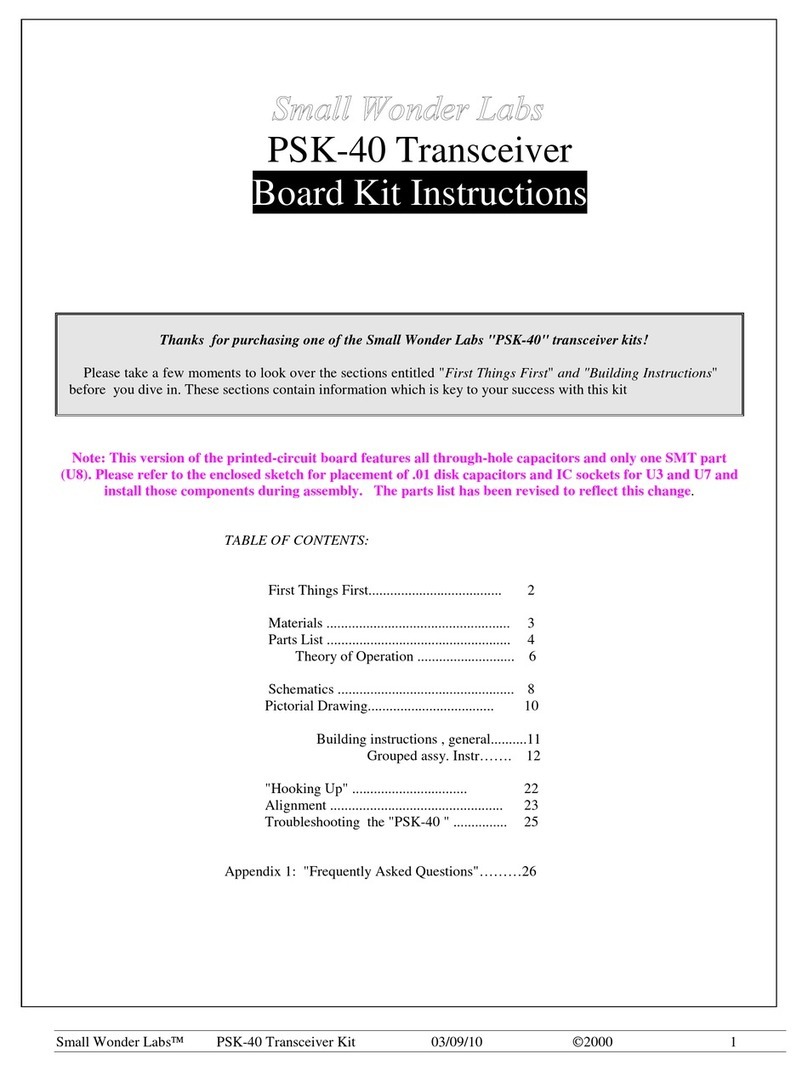
Small Wonder Labs
Small Wonder Labs PSK-40 User manual
